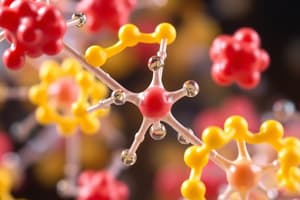Podcast
Questions and Answers
What is the specific region on an enzyme where the substrate binds and catalysis occurs?
What is the specific region on an enzyme where the substrate binds and catalysis occurs?
- Substrate binding site
- Biocatalyst site
- Active site (correct)
- Cofactor site
What is the complete, functional enzyme that is catalytically active and consists of an apoenzyme together with its cofactors called?
What is the complete, functional enzyme that is catalytically active and consists of an apoenzyme together with its cofactors called?
- Biocatalyst
- Holocatalyst
- Functional enzyme complex
- Holoenzyme (correct)
What is the compound on which an enzyme acts called?
What is the compound on which an enzyme acts called?
- Cofactor
- Biocatalyst
- Reactant
- Substrate (correct)
What do enzymes do to the energy barrier required for a reaction to occur?
What do enzymes do to the energy barrier required for a reaction to occur?
What are small organic molecules that act as cofactors called?
What are small organic molecules that act as cofactors called?
What is the term for the energy required by all reactants (substrates) before they will react?
What is the term for the energy required by all reactants (substrates) before they will react?
Which type of specificity refers to an enzyme acting on a particular steric or optical isomer?
Which type of specificity refers to an enzyme acting on a particular steric or optical isomer?
What type of model explains that the active site of the unbound enzyme is complementary in shape to the substrate and does not change at all?
What type of model explains that the active site of the unbound enzyme is complementary in shape to the substrate and does not change at all?
In enzymatic actions, what are cofactors that are tightly bound called?
In enzymatic actions, what are cofactors that are tightly bound called?
Which family of enzymes assists in the breakdown of lipids?
Which family of enzymes assists in the breakdown of lipids?
What is the term for the energy required by all reactants (substrates) before they will react?
What is the term for the energy required by all reactants (substrates) before they will react?
Which family of enzymes assists in the breakdown of lipids?
Which family of enzymes assists in the breakdown of lipids?
What are small organic molecules that act as cofactors called?
What are small organic molecules that act as cofactors called?
What type of specificity refers to an enzyme acting on a particular steric or optical isomer?
What type of specificity refers to an enzyme acting on a particular steric or optical isomer?
What is the specific region on an enzyme where the substrate binds and catalysis occurs?
What is the specific region on an enzyme where the substrate binds and catalysis occurs?
Which type of enzyme specificity refers to the enzyme acting on molecules with specific functional groups?
Which type of enzyme specificity refers to the enzyme acting on molecules with specific functional groups?
What is the term for enzymes that require metal ions as loosely bound cofactors?
What is the term for enzymes that require metal ions as loosely bound cofactors?
Which model of enzyme binding explains that the enzyme changes its shape for substrate binding?
Which model of enzyme binding explains that the enzyme changes its shape for substrate binding?
What type of molecules are cofactors that are small organic molecules called?
What type of molecules are cofactors that are small organic molecules called?
Which family of enzymes is used to break protein down into peptides in the stomach?
Which family of enzymes is used to break protein down into peptides in the stomach?
Study Notes
Enzyme Structure and Function
- The specific region on an enzyme where substrate binding and catalysis occur is called the active site.
- A complete, functional enzyme consists of an apoenzyme combined with its cofactors, referred to as a holoenzyme.
- The compound on which an enzyme acts is known as the substrate.
Enzyme Mechanism
- Enzymes lower the energy barrier required for a reaction to occur, thereby increasing the reaction rate.
- The energy required by all substrates before they will react is known as activation energy.
Cofactors and Enzyme Specificity
- Small organic molecules that function as cofactors are called coenzymes.
- Enzyme specificity can refer to acting on a particular stereoisomer or optical isomer (stereospecificity).
- Enzymes can also exhibit specificity for molecules with specific functional groups.
Enzyme Models and Binding
- The lock-and-key model explains that the active site of the unbound enzyme is complementary in shape to the substrate and does not change.
- The induced fit model allows for the enzyme to change shape upon substrate binding for optimal interaction.
Types of Cofactors and Enzymes
- Tightly bound cofactors are referred to as prosthetic groups.
- Enzymes that require metal ions as loosely bound cofactors are known as metalloenzymes.
- The family of enzymes that assists in the breakdown of lipids is called lipases.
- Enzymes that break down proteins into peptides, such as those in the stomach, belong to the family of proteases.
Studying That Suits You
Use AI to generate personalized quizzes and flashcards to suit your learning preferences.
Description
This quiz covers the basics of enzymes in biochemistry, including their role as catalysts, substrates, and holoenzymes. Presented by Dr. Michael Mounir from the Faculty of Science at Helwan University.




